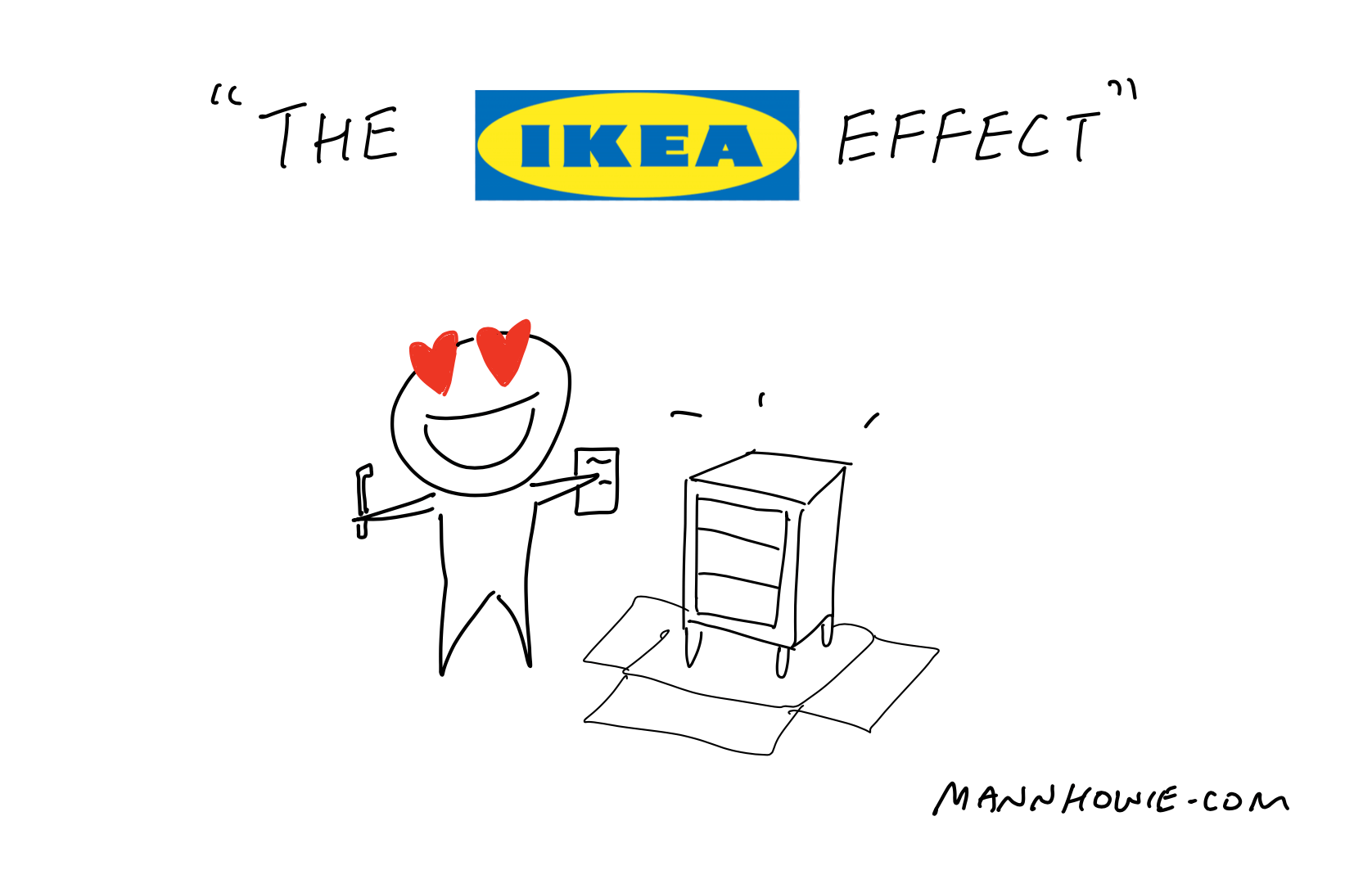The IKEA Effect - Why people fall in love with their own ideas
6 minute read | Sep 3, 2022
management, product
The IKEA effect describes how people come to overvalue things in which they have successfully put effort into. This cognitive bias can pose risks to organisations in the form of sunk cost effects and “not invented here” syndrome.

This article explains when and why the IKEA effect emerges and introduces four ways you can defend against it.
1. What is the IKEA effect?
The IKEA effect is a finding that people tend to ascribe a higher valuation towards self-assembled products compared to objectively similar products which they did not assemble.
A study by Norton, Mochon and Ariely (2011 paper) found participants who self-assembled an IKEA storage box (Builders) valued the purchase price 63% higher than those who inspected the same pre-assembled box (Non-Builders). Similarly, the Builders also rated liking the box 55% more than Non-Builders.
IKEA Effect Experiment A - Perceived value of IKEA storage box by Builders vs Non-Builders
| Measure | Builders (Self-assemble) | Non-Builders (Inspect pre-assembled) | % Difference |
|---|---|---|---|
| Willingness To Pay (0-100 cents scale) | 78 | 48 | 63% |
| Liking of Box (1-7 scale) | 3.8 | 2.5 | 52% |
Participants: N = 50
In another experiment one group of participants were asked to create origami (Builders) and another asked to inspect their creation (Non-Builders). Similar to the first experiment, the Builders valued their creation 360% higher than the Non-Builders who ascribed close to no value to the origami (“nearly worthless crumpled paper”).
IKEA Effect Experiment B - Perceived value of origami creation by Builders vs Non-Builders
| Measure | Builders (Self-create) | Non-Builders (Inspect creation) | % Difference |
|---|---|---|---|
| Willingness To Pay (0-100 cents scale) | 23 | 5 | 360% |
Participants: N = 106
2. Pitfalls of the IKEA effect
The IKEA effect explains broadly why people may come to fall in love with their own ideas. With the effect strongest when people expend a greater amount of their own effort and perceive their effort as successful.
The IKEA effect has negative implications for organisations more broadly as a contributor to two key organisational pitfalls:
- Sunk cost effects: people continue to devote resources to failing projects in which they have previously invested
- “Not invented here” syndrome: people refuse to use perfectly good ideas developed elsewhere in favour of their own, often inferior internally-developed ideas
Here are some examples of how the pitfalls could occur:
| Team | Effort | Pitfall ⚠️ |
|---|---|---|
| Fund Manager | Creating a company financial model with industry and market share forecasts | Perceiving company to be more valuable than it may be even when forecasts are not met |
| Sales Executive | Developing a sales slide deck on a unique selling proposition | Selling the solution instead of listening for customer struggles |
| Product Designer | Building high fidelity prototype of MVP product | Over Indexing visual design feedback and distracting from focus on user goals |
| Growth Marketer | Developing Account Based Marketing strategy based on LinkedIn research | Avoid comparing cost of acquisition vs other more effective initiatives like SEO and direct prospecting |
3. Four ways to avoid the IKEA effect
Here are four ways you can avoid and defend against the IKEA effect.
1. Acknowledge your unconscious bias
In the IKEA effect study, participants were found to be unaware of their unconscious bias. 92% of the participants when asked said they would pay more for pre-assembled products compared to self-assembly. This was in direct contradiction of their actions in the study.
Acknowledging you are prone to the cognitive bias of the IKEA effect can be the most effective way to mitigate against it. When completing an effort on a solution or idea, admit to yourself that you probably love it more than other solutions, because you worked on it.
2. Spike rough prototypes
The IKEA effect study found that the effect was strongest only when the effort was successful. Failure to complete tasks had corresponding negative psychological consequences. People ruminate more on tasks they failed to complete than on those they successfully completed, leading to negative affect and regret.
Spike rough prototypes and MVPs to test ideas early. Embrace sharing ideas that you are embarrassed with so it will be easier to cull.
3. Talk to customers
Framing your solutions and efforts towards the customer struggle can help mitigate your bias against any one solution.
Talking to customers is the best way to achieve this. Learn how to conduct user interviews to surface customer's struggling moments and understand why they don't love their current solutions (example user interview questions).
4. Run growth experiments
Growth experiments can help mitigate against confirmation bias by setting the discipline to state the problem statement, hypothesis and success criteria upfront before expending effort on a solution. Learn how to run your own growth experiment in this tutorial (How to run a growth experiment).
The Build, Measure and Learn framework popularised by Eric Ries in his book The Lean Startup explains how to apply a learning and feedback loop to measure the success of products and solutions.
Sources
- Norton, M. I., Mochon, D., & Ariely, D. (2012). The IKEA effect: When labor leads to love.
- Ries, Eric. The Lean Startup. (2011)
Want more tips?
Get future posts with actionable tips in under 5 minutes and a bonus cheat sheet on '10 Biases Everyone Should Know'.
Your email stays private. No ads ever. Unsubscribe anytime.